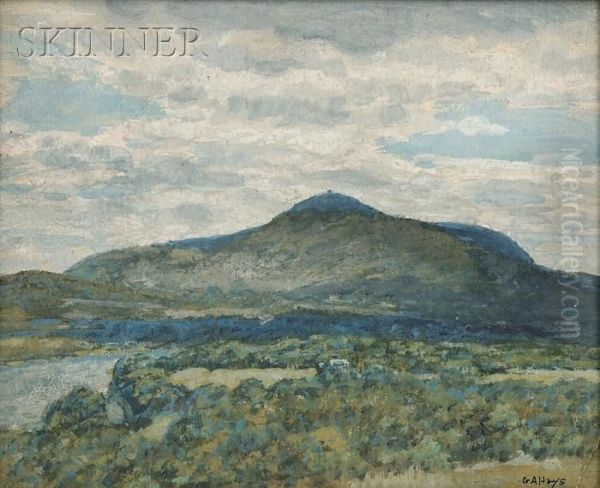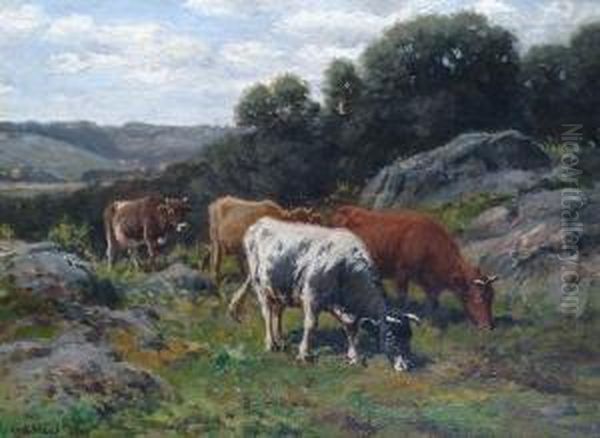George Arthur Hays (1854-1934) stands as a notable figure in American landscape painting, particularly cherished for his tranquil depictions of New England scenery, often populated by his signature cattle. A self-taught artist, Hays carved a niche for himself within the vibrant artistic milieu of late 19th and early 20th century America, contributing a body of work that reflects both the prevailing tastes of his era and a personal connection to the pastoral ideal. His life and career, centered largely in Rhode Island, offer a glimpse into the regional art scenes that flourished outside major metropolitan hubs like New York or Boston, yet were integral to the fabric of American art.
Early Life and Artistic Awakening
Born in Greenville, New Hampshire, in 1854, George Arthur Hays emerged into an America that was increasingly finding its artistic voice, particularly in the realm of landscape painting. The Hudson River School, with titans like Thomas Cole and Asher B. Durand, had already established a grand tradition of celebrating the American wilderness. While Hays was younger, the echoes of this movement, with its emphasis on detailed observation and a romantic reverence for nature, would have permeated the cultural atmosphere.
Unlike many of his contemporaries who sought formal academic training in Europe or at prestigious American institutions, Hays was largely self-taught. This path, while challenging, often fostered a unique and unmediated vision. For Hays, it meant developing his skills through direct observation of nature and, presumably, through studying the works of other artists accessible to him. His dedication to his craft is evident in the proficiency he achieved, particularly in capturing the subtle interplay of light and atmosphere that characterized the New England countryside. His chosen mediums, watercolor and oil, allowed him a versatile range to express these observations.
The Pastoral Motif: Landscapes with Cattle

The hallmark of George Arthur Hays's oeuvre is undoubtedly his focus on landscapes featuring cattle. This was not an uncommon subject in 19th-century art; European artists of the Barbizon School, such as Constant Troyon and Rosa Bonheur, had popularized animal painting and pastoral scenes, and their influence was felt across the Atlantic. American artists like William Morris Hunt, who studied with Jean-François Millet (another Barbizon master), helped introduce these sensibilities to New England.
Hays’s cattle are rarely depicted with dramatic flair or as mere agricultural commodities. Instead, they are integral, peaceful components of the landscape, often shown grazing contentedly in sun-dappled fields, resting under the shade of mature trees, or wading in gentle streams. These scenes evoke a sense of tranquility, nostalgia, and an idealized vision of rural life that appealed to a society undergoing rapid industrialization and urbanization. His work can be seen as part of a broader current in American art that sought solace and enduring values in the natural world, a sentiment also explored by Tonalist painters like George Inness or Dwight William Tryon, though Hays's style was generally more direct and less overtly moody than theirs.
Artistic Style and Technique
As a self-taught artist, Hays developed a style characterized by careful observation and a competent, if not revolutionary, handling of paint. His landscapes are typically well-composed, with a good sense of depth and atmospheric perspective. His palette often reflects the gentle hues of the New England seasons – the fresh greens of spring, the warm tones of summer, and the russet and gold of autumn.
In his oil paintings, Hays demonstrated a solid understanding of form and texture, rendering the coats of his cattle and the foliage of trees with a convincing realism. His watercolors, a medium favored for its portability and immediacy, likely allowed him to capture fleeting effects of light and weather with greater spontaneity. The consistent theme across his work is a gentle realism, focused on the beauty of the everyday rural scene rather than the sublime grandeur that had captivated earlier generations of American landscape painters like Albert Bierstadt or Frederic Edwin Church. Hays's vision was more intimate, akin perhaps to the more pastoral works of some Hudson River School artists in their later phases, or contemporary regional landscape painters.
The Providence Art Scene and Affiliations

George Arthur Hays spent a significant portion of his life in Providence, Rhode Island, which had a thriving artistic community. He became deeply involved in this local art world, a common and vital support system for artists of the period. His membership in the Providence Art Club was particularly important. Founded in 1880, the Providence Art Club was one of the oldest such organizations in the United States, providing exhibition opportunities, studio space, and a collegial environment for artists. Figures like Edward Mitchell Bannister, an acclaimed African American landscape painter, and Charles Walter Stetson were prominent in Providence art circles around this time.
Hays was also a member of the Society of Independent Artists and the Providence Watercolor Club. The Society of Independent Artists, particularly its New York iteration famous for the 1917 exhibition that included Marcel Duchamp's "Fountain," championed the idea of no-jury, no-prizes exhibitions, allowing a broad range of artists to show their work. Hays's affiliation suggests an openness to more progressive exhibition practices, even if his own style remained relatively traditional. His involvement with the Providence Watercolor Club underscores his proficiency and interest in this distinct medium, which had its own dedicated following and societies. He was also associated with the Copley Society in Boston (then the Boston Art Students Association), another significant New England art institution.
Representative Works: Under the Oak and Mt. Tobie
While a comprehensive catalogue raisonné of Hays's work may not be widely accessible, certain titles surface, offering glimpses into his typical subjects. Under the Oak and Mt. Tobie are two such examples, noted as having been offered by Skinner Auctioneers in 2010.
Under the Oak perfectly encapsulates his favored theme. One can envision a scene of pastoral calm: a sturdy oak tree providing shade, with a small herd of cattle resting or grazing beneath its boughs. Such a composition would allow for an exploration of light filtering through leaves, the textures of bark and animal hide, and the peaceful ambiance of a summer's day. This motif was popular among many landscape painters, including those of the Barbizon school and their American followers, for its symbolic representation of nature's endurance and shelter.
Mt. Tobie suggests a more specific landscape, likely a depiction of Mount Toby in Sunderland, Massachusetts, a notable feature in the Connecticut River Valley. This indicates Hays also engaged with identifiable local scenery, a practice common among regional landscape painters. Such a work would have allowed him to tackle the challenges of rendering mountainous terrain, atmospheric perspective, and perhaps the specific light conditions of that area. Without viewing the paintings, it's hard to be definitive, but the titles align perfectly with his known artistic preoccupations. The specific creation dates for these works are not readily available, which is common for many regionally recognized artists whose careers are not as exhaustively documented as their more famous counterparts.
Hays in the Context of His Contemporaries
To fully appreciate George Arthur Hays, it's useful to consider him alongside other artists active during his lifetime. The late 19th and early 20th centuries were a period of diverse artistic exploration in America. While Impressionism was making inroads with artists like Childe Hassam and John Henry Twachtman, many painters continued to work in more traditional representational styles.
Hays’s pastoralism can be contrasted with the more rugged and dramatic seascapes of Winslow Homer, or the society portraits of John Singer Sargent. His focus on gentle, rural scenes aligns him more closely with a vein of American art that celebrated the agrarian ideal. Artists like Horatio Walker, known as "the American Millet," also depicted scenes of rural labor and farm life, though often with a more heroic or sentimental tone. Hays’s work seems to possess a quieter, less overtly narrative quality.
His dedication to the New England landscape places him in a lineage that includes earlier figures like Fitz Henry Lane, known for his luminous, tranquil marine scenes, and contemporaries who specialized in capturing the unique character of the region. While Hays may not have experimented with the broken brushwork of the Impressionists or the subjective color of Post-Impressionism, his commitment to depicting the familiar world around him with sincerity and skill gives his work its enduring appeal. He shared with many artists of his generation, such as Willard Metcalf, a love for the New England landscape, though Metcalf's approach was filtered through an Impressionist lens.
The Market and Legacy of George Arthur Hays
George Arthur Hays achieved a degree of recognition during his lifetime, primarily within New England. His participation in various art clubs and societies ensured his work was regularly exhibited and seen by regional audiences and collectors. The continued appearance of his paintings in auctions today indicates an ongoing, if modest, market interest. Collectors of traditional American landscape painting, particularly those with an affinity for New England scenes or pastoral subjects, are likely to appreciate his work.
The fact that Hays was self-taught might have, in some academic circles of his time, placed him outside the mainstream of formally trained artists. However, the American art scene has often shown a particular appreciation for individualistic and self-made talents. His dedication to his craft and his consistent output over several decades mark him as a serious professional artist.
Assessing the direct influence of George Arthur Hays on subsequent generations of artists is challenging without more extensive art historical research specifically focused on his career and connections. However, as part of a collective of artists who lovingly documented the American landscape, he contributed to a visual heritage that continues to resonate. His work serves as a reminder of the quiet beauty of the rural past and the importance of regional art centers in the broader narrative of American art. He, like many proficient regional artists such as John Joseph Enneking of Boston, contributed to the rich tapestry of American art without necessarily instigating major stylistic shifts.
Conclusion: A Quiet Chronicler of Rural Beauty
George Arthur Hays passed away in Providence, Rhode Island, in 1934, leaving behind a legacy of paintings that celebrate the serene beauty of the New England countryside. As a self-taught artist, he honed his skills to capture the pastoral landscapes and, most notably, the gentle presence of cattle within them. His active participation in the Providence art scene and other New England art organizations demonstrates his commitment to his profession and his community.
While perhaps not a revolutionary figure in the grand narrative of art history, George Arthur Hays holds a respectable place as a skilled practitioner of American landscape painting. His works offer a window into a gentler, more agrarian America, rendered with sincerity and a clear affection for his subjects. For those who appreciate the subtle charms of traditional landscape art and the specific character of New England scenery, the paintings of George Arthur Hays remain a source of quiet enjoyment and a testament to a dedicated artistic life. His contribution, like that of many artists who find their inspiration in their immediate surroundings, enriches our understanding of America's diverse artistic heritage.